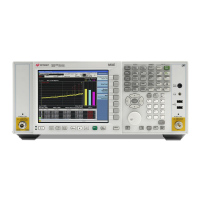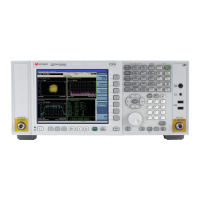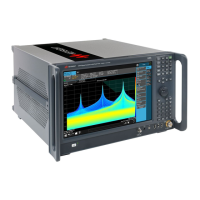Keysight N9038A MXE Service Guide 259
RF Downconverter Section
RF Downconverter Section Troubleshooting
High Band Signal Path (3.6 GHz and Higher)
There are multiple frequency bands in the high band signal path. These can be
seen in Table 6-1 as well as in the series of block diagrams found in Chapter
15, “Block Diagrams.”.
1. Remove the instrument dress cover (MP24) and top brace (MP10). Refer to
Chapter 18, “Assembly Replacement Procedures.” for instructions on
removing these covers.
2. Remove the hardware that attaches the front frame assembly to the
chassis and slide it away from the rest of the instrument, but do not
disconnect W8 which connects it to the A8 Motherboard assembly. Refer
to Chapter 18, “Assembly Replacement Procedures.” for instructions on
removing the front frame assembly.
3. Referring to Figure 6-17 or Figure 6-18, disconnect W14 from the A13 RF
Front End assembly Output (J7).
4. Connect a spectrum analyzer to the A13 RF Front End assembly Output
(J7).
5. Tune the spectrum analyzer to 322.5 MHz with a span of 10 MHz.
6. Referring to Figure 6-17 or Figure 6-18, disconnect W40 from the A13 RF
Front End assembly high band Input (J9).
7. Connect a signal generator to the A13 RF Front End assembly high band
Input (J9), using a cable designed for use at this frequency.
8. Tune the signal generator to 10 GHz with an amplitude of -30 dBm.
9. Turn the instrument on and allow it to complete its boot up process.
10.Turn the instrument self-alignment routine off by pressing System,
Alignments, Auto Align, Off.
11.Tune the instrument to 10 GHz with a span of 0 Hz by pressing FREQ,
10 GHz and SPAN, Zero Span.
12.Verify that the signal amplitude on the spectrum analyzer display is at
least -10 dBm (15 dB gain), allowing for any additional test cable loss, as
seen in Figure 6-22.
If there is a particular frequency of interest use that instead of the 10 GHz used in this example.
Be aware that the gain at higher frequencies in low band will have a slightly lower gain than that
shown in this example.

